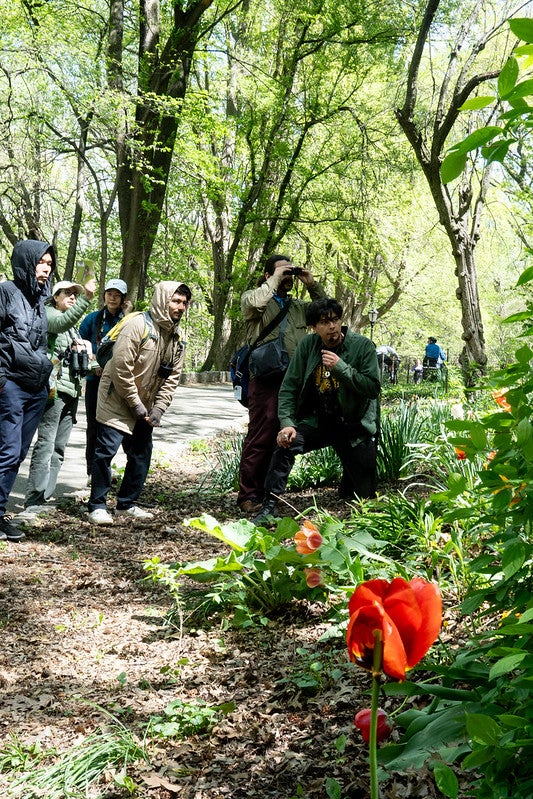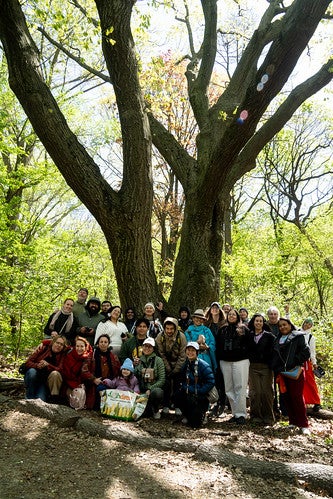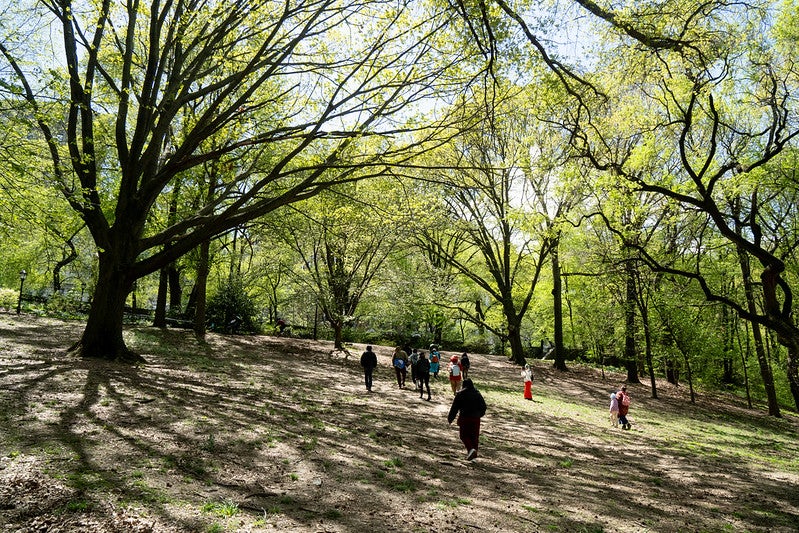
By Oliver Lopez
On a breezy morning in April 2025, after a long week of discussions at the 24th session of the UN Permanent Forum on Indigenous Issues, 32 delegates, Indigenous leaders, and Elders from around the world were invited by Comunidad Integradora de Saberes Andinos (CISA) and New York City’s Riverside Park Conservancy to gather at the Riverside Park Bird Sanctuary.
The Bird Sanctuary is a forested area within Riverside Park that stretches from 116th Street to 125th Street. Its wide walking trail is heavily used by the public all year round. Some people race through the trails as part of their running route, some enjoy a stroll through the tranquil space, and others take their time in the forest to immerse themselves in nature and observe several species of birds calling the forest home. On this particular spring morning, the Bird Sanctuary became the focal point for people representing Indigenous communities around the globe.
To open the program, Spanish translator and guide, Cristina Lalama, sang a healing song to Mother Earth as the bells of the Riverside Church rang out in the distance. Each participant was given a hand-illustrated flyer about the soaring red-tailed hawk and a pair of binoculars. Aromatic wisps of copal curls carried notes of earth and resin, setting a reverent tone for the journey into the Bird Sanctuary on Lenape land.

Guided Nature Walk
Oliver Lopez is the caretaker of the Bird Sanctuary at Riverside Park Conservancy and a passionate activist for Indigenous rights and lands. He guided attendees through the Bird Sanctuary, pointing out the native flora and fauna, while Lalama translated the tour into Spanish. Under the dappled canopy of budding trees and new leaves, Lopez invited the group into five minutes of silent meditation. Eyes closed, the group breathed in the fragrance of early spring and leaned into the chorus of warbling white-throated sparrows and the sharp calls of blue jays.
Emerging from silence, the group approached the Sanctuary’s “Mother Tree,” a magnificent oak tree easily three centuries old. Its trunk was broad enough for many people to embrace, and its roots fanned outward like open arms. Children and Elders rested their foreheads against the bark, imagining the hidden underground networks threading life through every living thing. A quick scan with binoculars uncovered an American robin’s nest tucked in an American holly and a surprise glimpse of a migratory towhee foraging among fallen leaves below.

Ceremony and Connection
At the Field House, the group gathered in a circle. Mampujark Miriam Sánchez, Executive Director of CISA, opened an Andean Four Suyus ceremony with a blend of prayer, song, and ritual objects arranged on a woven blanket. Her ceremony vibrated in the room as she called in spirits from the high Andean mountains to the depths of the Amazon. One by one, she blessed attendees with copal smoke and Amazonian plants. When she raised her voice in a final prayer, threads of unity weaved the group together—people from North and South America, Europe, and Asia, each listening with rapt attention, feeling the power of the shared experience.
Next, Blaine Grinder rose, eagle feather in hand, and began with a haunting melody accompanied by steady drum beats. His song carried the group north to Tsilhqot’in territory, his voice echoing ancestral resilience. In his talk, Grinder honored his Elders’ oral testimonies. He recounted the long fight for Teztan Biny (Fish Lake) against Taseko Mining LTD and celebrated the landmark victory recognizing Tsilhqot’in’s land rights. He wove in stories of sickened rivers, youth learning their language and stewardship practices, and cross-border solidarity of Canadian and Guatemalan communities rallying against destructive mining.

Collaborative Dialogue
Inspired by Grinder’s talk, the floor was opened with Professor Coro Juanena guiding the discussion on ways to integrate Indigenous practices into urban parks. Ideas around how public urban parks can be natural healing spaces for organizing, cultural exchange, and learning flowed easily. Among the suggestions were monthly cultural performances such as dance showcases highlighting and reinforcing diverse Indigenous traditions; ‘Learning Groves,’ or designated natural spaces where urban Indigenous youth and Elders meet monthly to share and practice traditions; protected areas in the park where ceremonies can be held respectfully and without interruption; and youth ambassador programs empowering young people to share their cultures with broader audiences.
Participants also praised the guided nature walks as a powerful way to incorporate Indigenous ecological knowledge into city life. Each suggestion wove together like the mycorrhizal networks beneath the Mother Tree—connected, supportive, and alive.

Why “Nature & Resistance”?
Amid intense sessions at the 24th UN Permanent Forum on Indigenous Issues, a simple truth became evident: when our spirits reconnect with the land, we remember our responsibilities and rights.
“Nature & Resistance” encapsulates this truth, signifying that our connection to nature is not just about appreciation, but also about defending it. The event was born to offer delegates a space to breathe, listen, and rebuild community through shared experience and love for nature. Here, the health of the individual, the community, and the ecosystem is inseparable.
Riverside Park Conservancy generously opened the Field House and provided logistical expertise, demonstrating their commitment to promoting Indigenous knowledge in city parks. CISA provided support with their cultural guidance and connections brought to life through Sánchez’s ceremony, Grinder's presentation, and Juanena’s exchange. Together, they demonstrated how cross-sector partnerships can uplift Indigenous knowledge in city parks worldwide.

Living Traditions, Growing Futures
The day in Riverside Park was a transformative experience, demonstrating what is possible when Indigenous wisdom stands at the heart of environmental stewardship. We emerged with new friendships, renewed hope, and a clear vision: that cities can become places where ceremonies continue, youth learn in nature, and where the rights of First Peoples guide every blade of grass we plant. As we departed, the rhythms of drums, song, and rustling leaves stayed with us—a living echo of resilience, connection, and the enduring power of our shared Earth, inspiring us to carry the torch of environmental stewardship forward.
--Oliver Lopez is a New York City-based environmental educator, bilingual bird and nature guide, and artist whose work bridges ecological stewardship and Indigenous knowledge. Originally from Ecuador, his early connection to nature near Chimborazo sparked his interest in environmental work. Through nature walks, art, restoration efforts, and visual storytelling, he creates inclusive spaces for healing, learning, and cultural exchange. Find his artwork and updates at @OliverNatureArt.
All photos by Sylvia Riberos.



